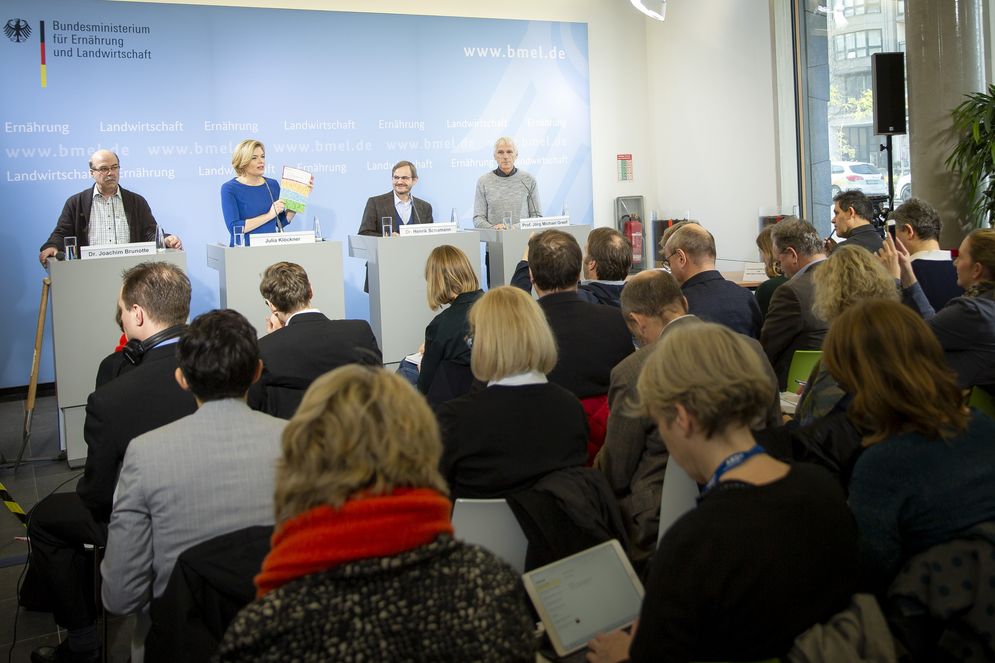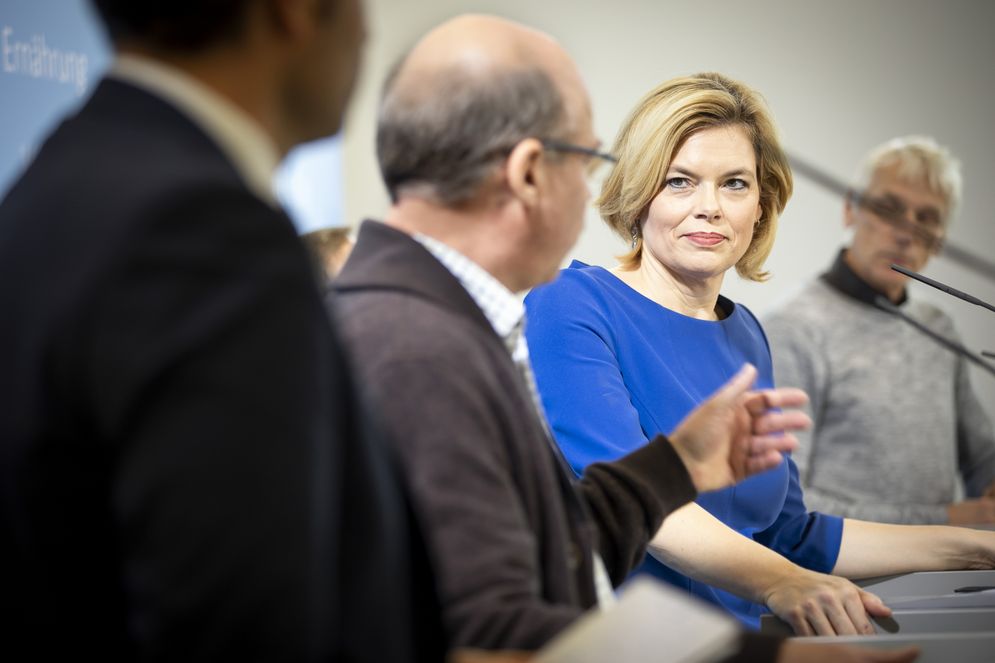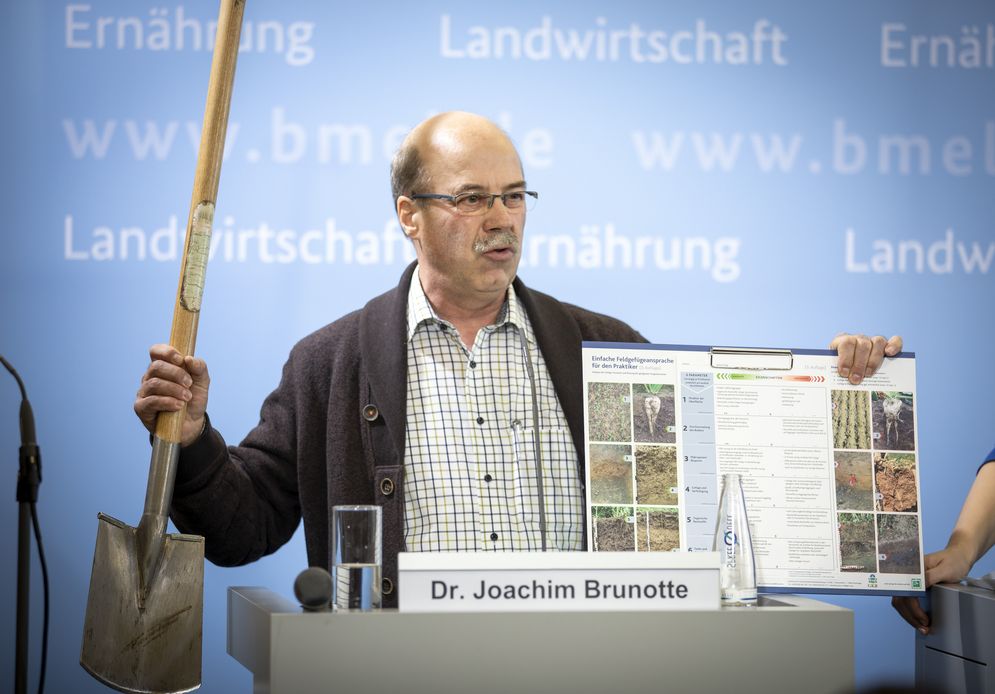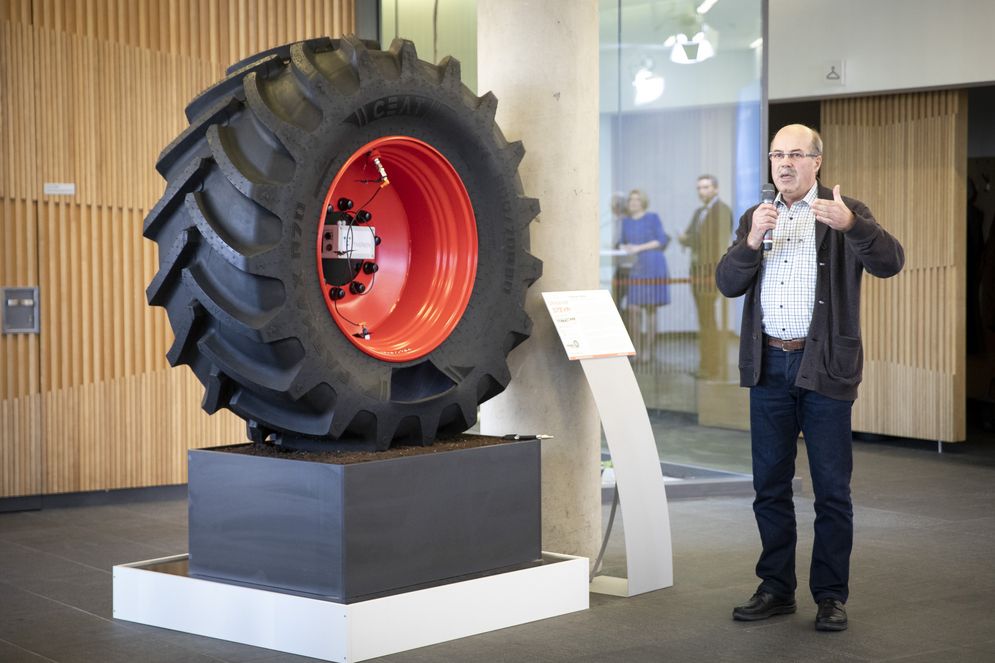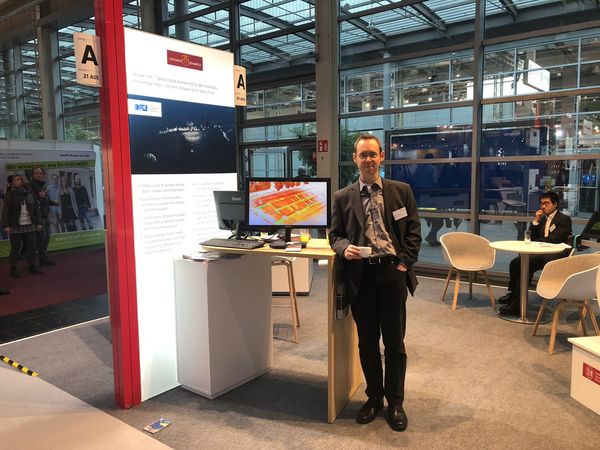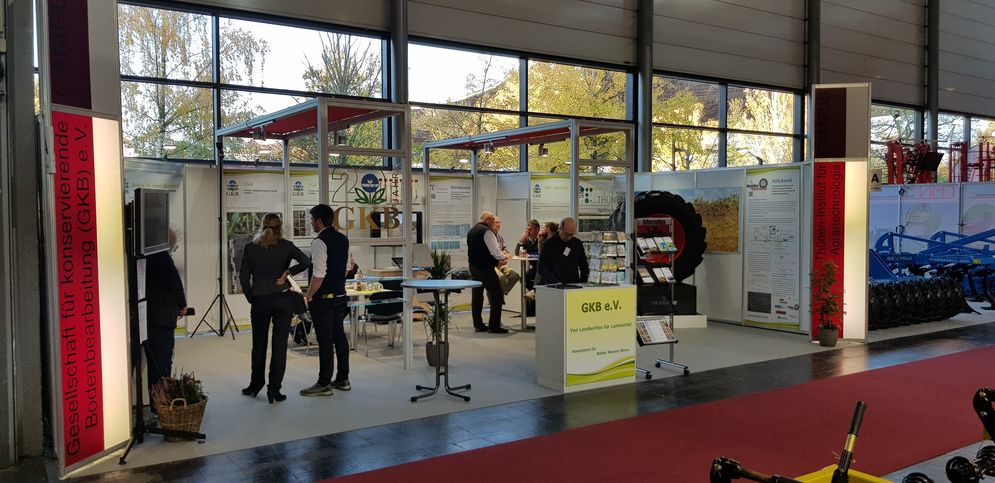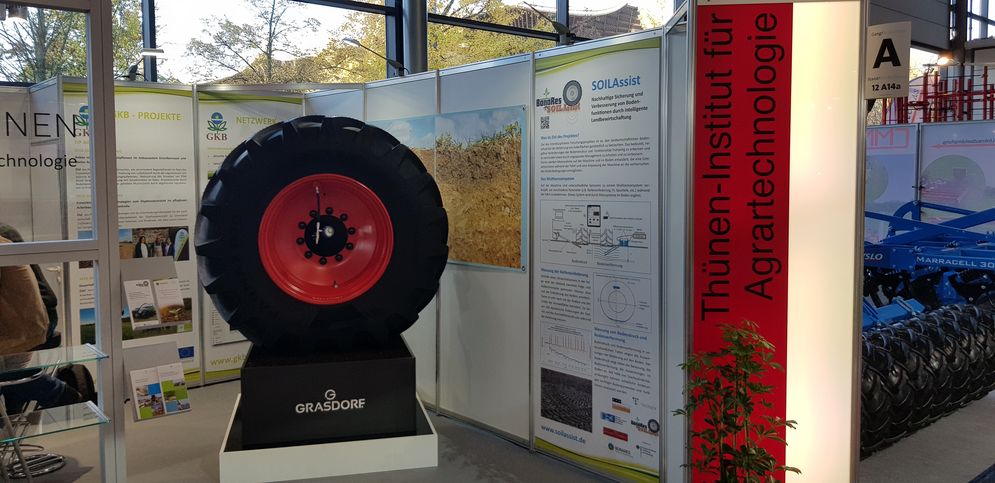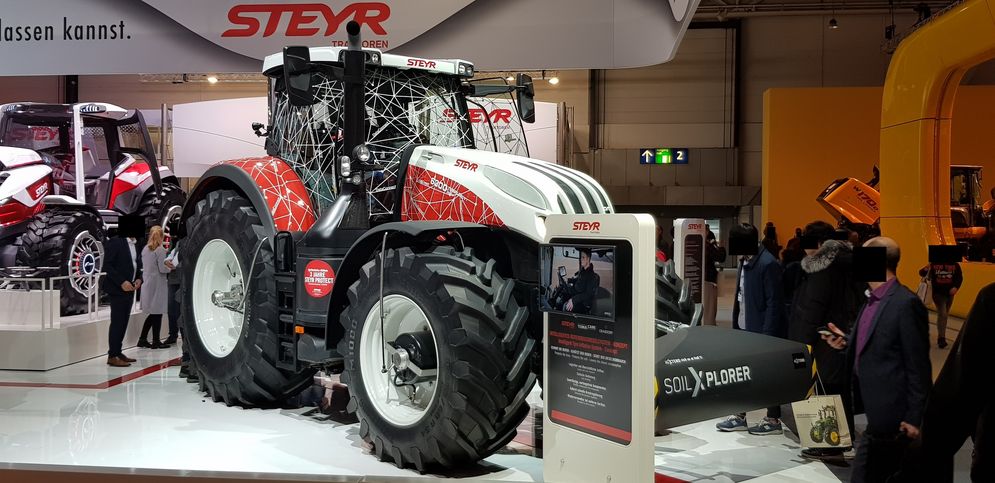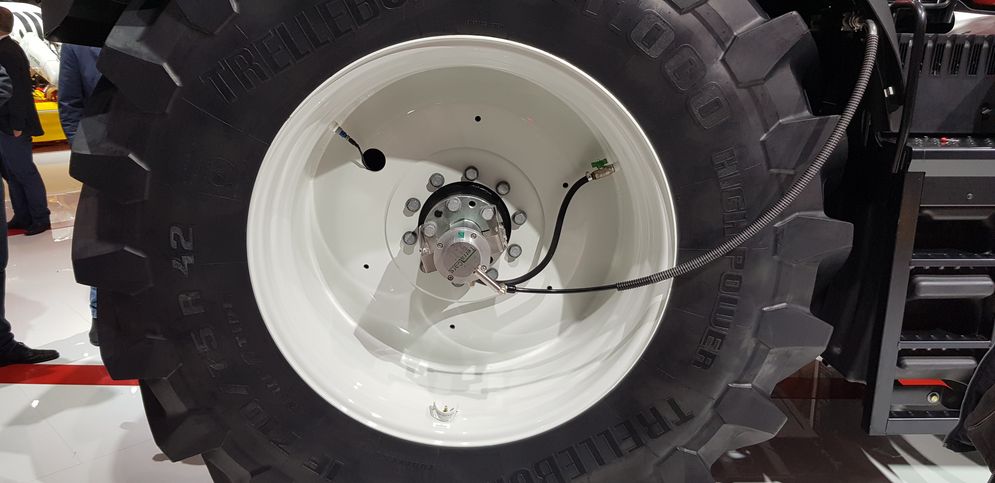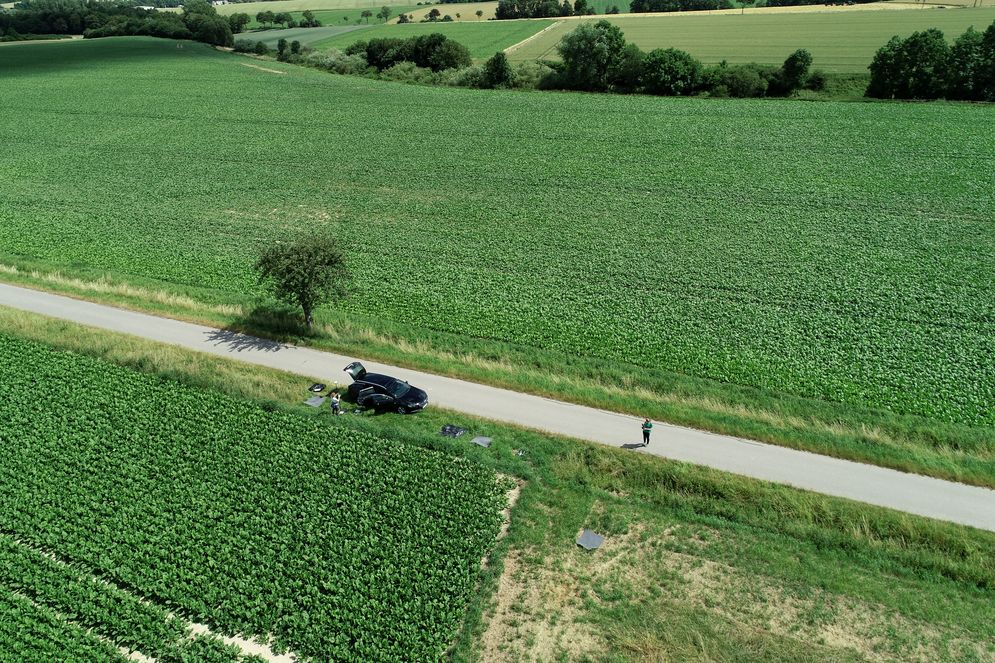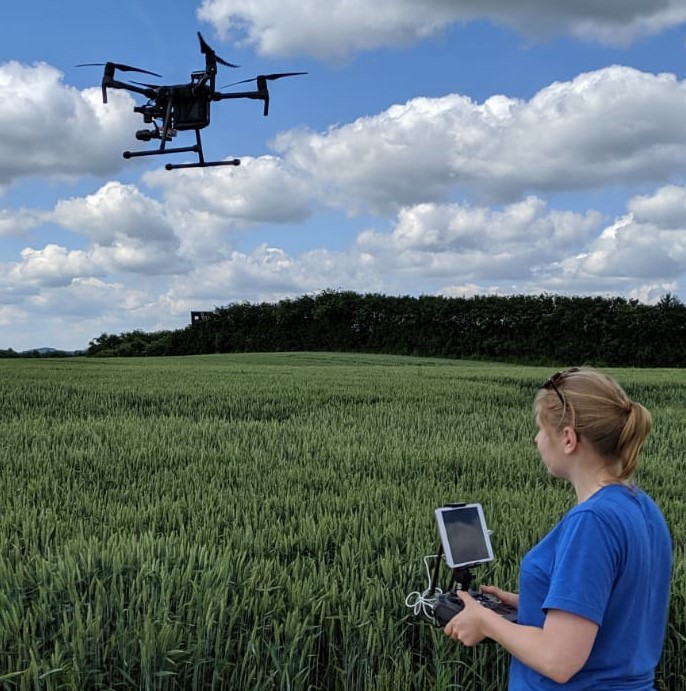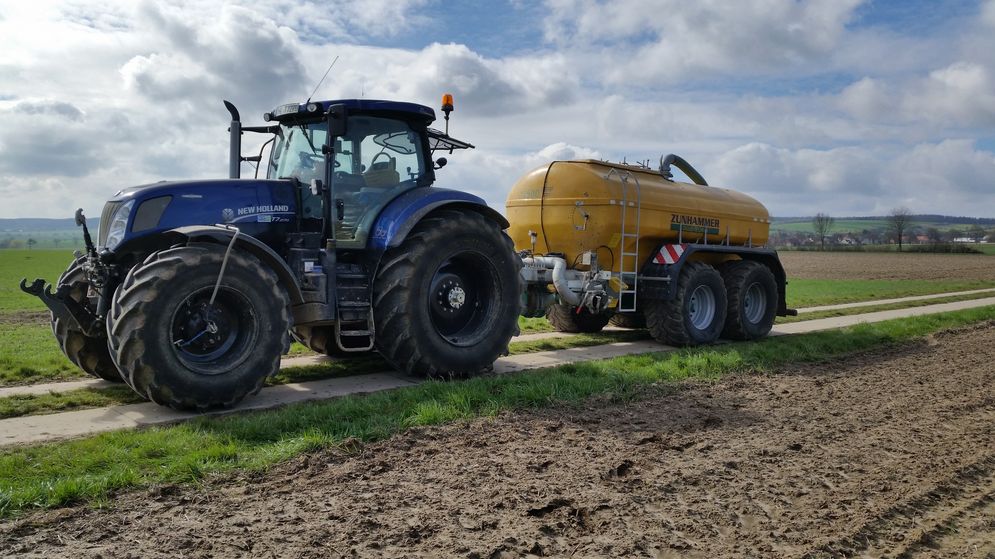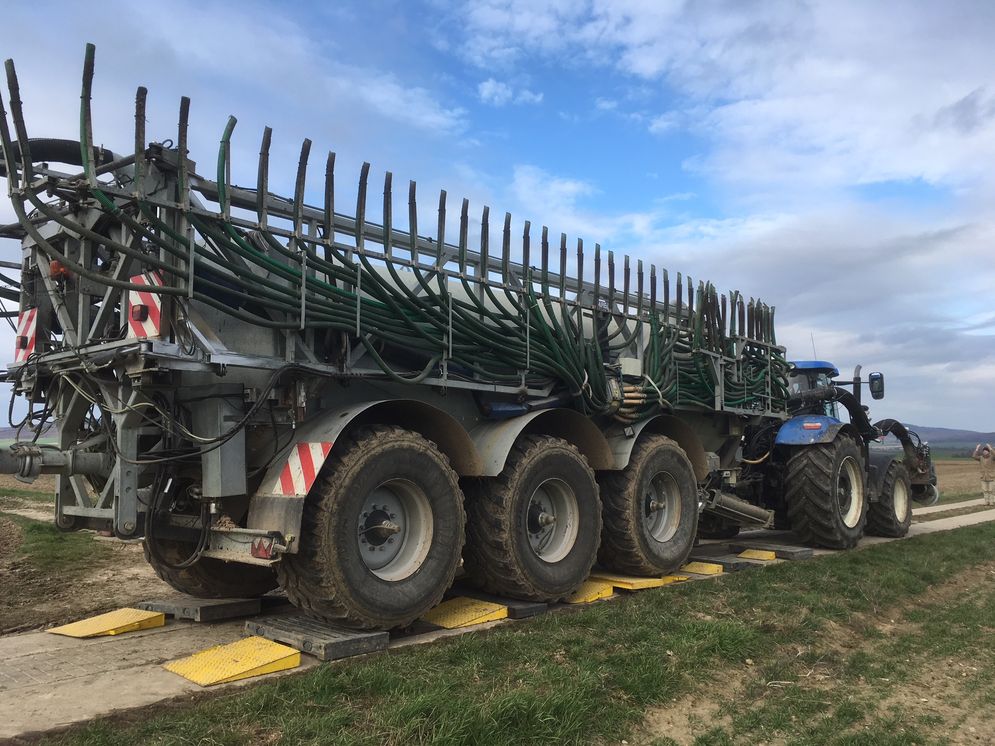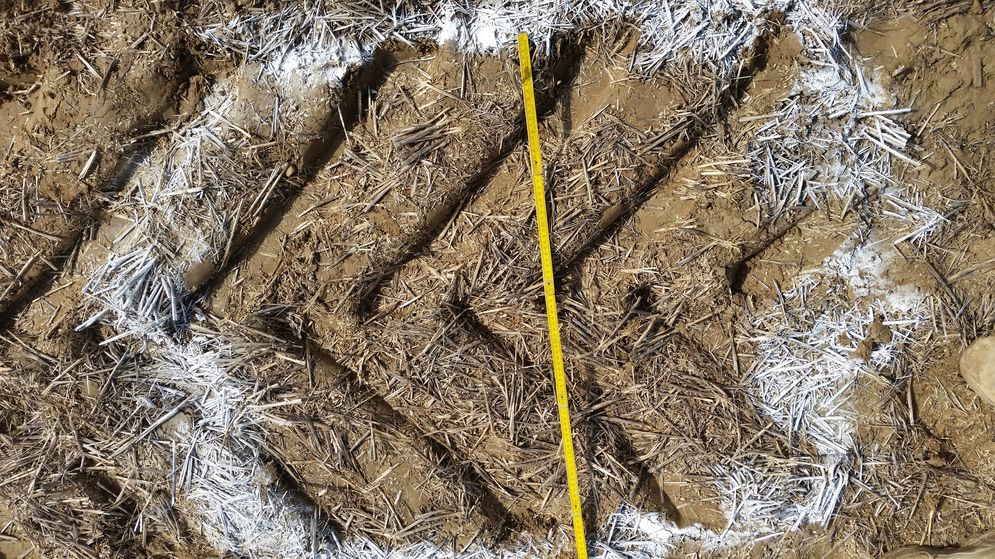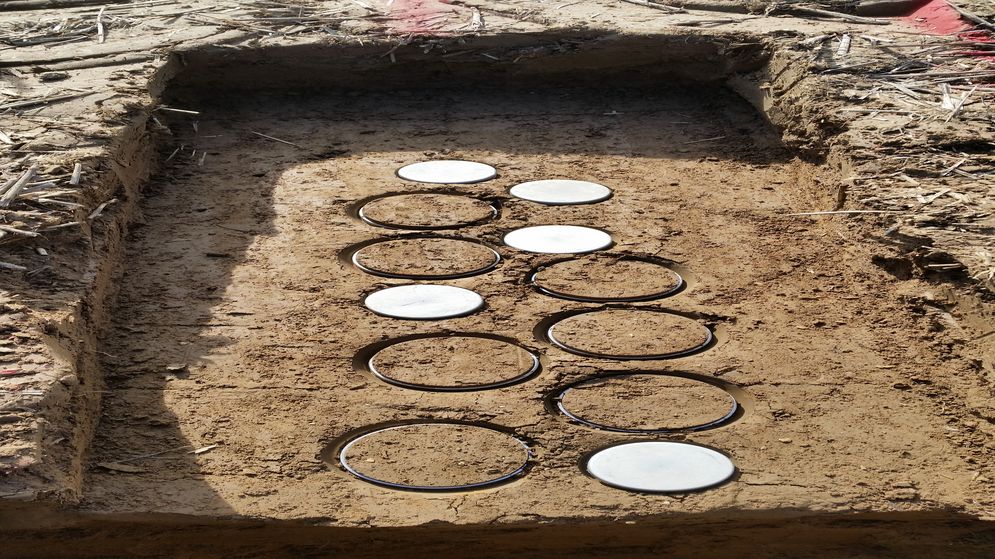SOILAssist project mananger Joachim Brunotte as an expert at the presentation of the discussion paper "Agricultural Strategy 2035" in Berlin
Presentation of the "Intelligent Wheel" at the press conference of Federal Minister of Food and Agriculture Julia Klöckner
SoilAssist project manager Joachim Brunotte from the Thuenen Institute of Agricultural Technology was invited to Berlin as an expert to present the discussion paper "Agricultural Strategy 2035". At the press conference of the Federal Minister of Food and Agriculture Julia Klöckner on December 19, 2019 he had the opportunity to present the "Intelligent Wheel" exhibit at the trade fair. The tire with the SoilAssist sensor system was developed in cooperation between our project and the companies Grasdorf Rad, Steyr and TerraCare.
Soil has an important role in the discussion paper "Agricultural Strategy 2035". As a basis for production, every effort must be made to maintain or improve soil fertility and thus soil functions. Against this background, the prevention of soil erosion during extreme weather events and precautions against soil compaction play a major role.
In order to use large and heavy agricultural machinery in a soil-conserving way, vehicle parameters must be adapted to the current susceptibility of the soil to compaction. Joachim Brunotte used the "Intelligent Wheel" to demonstrate ultrasonic sensors which help to measure tire deflection and thus permit maximum tire deflection in order to support the wheel loads on the largest possible tire contact area. This leads to a reduction in the soil pressure and thus to soil protection and its important functions.
The discussion paper "Agricultural strategy 2035" also included findings from extensive field trials on practical plots from various projects at the Thuenen Institute of Agricultural Technology. The agricultural strategy is divided into 6 guidelines and 12 fields of action. They serve as a framework for a sustainable orientation of arable farming:
1. Ensure the supply of food, feed and biogenic raw materials
2. Securing agricultural income
3. Strengthening environmental and resource protection
4. Strengthening biodiversity in the agricultural landscape
5. Extending the contribution to climate protection and adapting agriculture to climate change
6. Increase social acceptance of arable farming
Agritechnica - Semantic environmental representation for arable farming processes
SOILAssist partners Uni Osnabrück and DFKI at Agritechnica, hall 21, stand A05
Farming is knowledge-intensively. Knowledge about the process, the field, the machines, the crop, the weather and everything else traditionally lies in the mind of the farmer, who today also uses information systems, machine and satellite data as sources of information and means of documentation. Common farm information systems aggregate data about space and time. However, the functions for automatic knowledge-based inference from existing information are often limited, as are the machines involved in the process, because there is no explicit representation of the existing knowledge.
Our work in SoilAssist aims at using AI-methods for knowledge representation and interpretation of sensory data, process data and geographical data to fill this gap and to make automated conclusions and explanations available at the knowledge level in arable farming processes. In this way we develop new technologies, concepts and software solutions that contribute to improving efficiency, sustainability and yield in agriculture.
The system used in SoilAssist to record high-dimensional 3D point clouds will be presented at Agritechnica on the stand of the Lower Saxony Ministry of Science and Culture (hall 21, stand A05).
Agritechnica - New development from SoilAssist
Intelligent Wheel
The fully automatic control pressure system
At this year's Agritechnica the new developments in SOILAssist will also be presented together with the cooperating companies. Two identical models of a tire with the SOILAssist sensor system will be presented at the stand of the partner Grasdorf-Rad (hall 20, stand B08) and at the GKB-Thünen stand (hall 12, stand A14). The tires are open at the side for better visibility so that you can look inside the tire. The models explain how the system works.
The SOILAssist sensor system is still integrated in a Steyr tractor, which can be found at the stand of our partner Steyr (hall 3, stand A49). A video specially produced for Agritechnica shows how the system works on the tractor.
The system, developed in cooperation between SOILAssist, the tire and wheel specialist Grasdorf, the tractor manufacturer Steyr and the manufacturer of tire pressure control systems TerraCare, can automatically adjust the internal tire pressure to the existing driving conditions. For the first time, the advantages of a control pressure system can be fully exploited by fully automatic control without the need for manual intervention by the driver.
The partner Steyr developed a patented wireless capacitive energy transmission and wireless data transmission. With this intelligent system, the traction of the tire can be optimized, fuel consumption, tire wear and soil pressure minimized and tire damage prevented. Parameters such as wheel load, temperature, inflationl pressure etc. are also recorded. In connection with the complete integration into the existing vehicle information system, a multitude of further data can be accessed, resulting in additional application possibilities, such as fully automatic and calibration-free yield recording.
The exhibits can still be seen on the exhibition stands of the participating partners until 11/16/2019.
Press release
Bat technology helps protect the soil
Thünen Institute of Agricultural Technology at Agritechnica 2019
The Thünen Institute of Agricultural Technology will be represented at this year's Agritechnica, the world's largest trade fair for agricultural technology, from 10 to 16 November 2019 in Hanover. On a joint stand with the Gesellschaft für konservierende Bodenbearbeitung e.V. (Society for Conservative Soil Treatment) (GKB), possible solutions and techniques will be presented within the framework of the lead topic "Global Farming - Local Responsibility" in addition to the problems of soil compaction by agricultural field traffic. The necessity of hygiene measures on the field is also a topic.
Scientists in the SOILAssist project, use ultrasound - a technique that bats also use for orientation - to detect changes in tractor tires during field traffic at a resolution of 1/100 mm. This is used to dynamically determine changes in wheel loads and soil pressure under each tire while driving. Special measurements in the soil show whether field traffic lead to soil damage, with effects on the soil structure, plant growth, soil water balance or soil fauna. All the information flows together in a real-time assistance system on the machine. From this, situation-dependent recommendations are given to the driver. He can then adapt his machine to the current soil conditions, for example by changing the tire inflation pressure while driving, thus contributing to sustainable soil protection. At the Thünen-GKB fair stand, the cross-section of a tire with built-in sensors and a model for measuring soil deformation can be seen. Visitors will then be able to simulate the crossing with a tractor tire on the soil and see what happens in the tire and in the soil underneath.
Scientists from the Thünen Institute of Agricultural Technology are also presenting a bonitur scheme for corn stubble as a component for "Good Technical Practice" in field hygiene and soil cultivation. A holistic view of the work processes from cultivation to harvesting is necessary to justify the effective and profitable use of mulchers. Corn stubble must be completely shredded and frayed in order to deprive the larvae of the corn borer, the most important insect pest in corn, of their habitat and to accelerate rotting. The Bonitur scheme helps to assess in detail the framework conditions and the results of the work of the technology used. Visitors can test their knowledge on a monitor in a quiz.
All interested parties are invited to visit the Thünen-GKB fair stand in hall 12 at stand 12A14. Agritechnica with more than 2500 exhibitors from over 50 countries takes place every two years in Hanover. The organizer is the German Agricultural Society (DLG).
Sugar beet harvest october 2019
The dry summer of 2019 was followed by sufficient rainfall in autumn, so that the sugar beet harvest and the associated measurement campaign could take place at the end of October. This year, the harvest took place on test field 4. This field is the one with the greened headland. It was used for the turning of the beet harvester.
With the FiTraM model developed at CAU, it can be determined that the beet passes the soil in the headland 6 times with all three axles driving in the same track. This means that on average, a total of 18 wheel passes take place per point in the headland. During the soil investigation, the beet harvester with full bunker passes the measuring point 7 times and the soil pressure and deformation were measured with the multi-sensor system at three soil depths.
The beet harvester uses soil conserving crab steering system function. When harvesting the inner field area, every point in the field is thus passed once. In the inner field area the beet harvester passes the measuring point with only one wheel with half-full and full bunker. The soil pressure and the deformation were also measured.
To investigate the traffic-related changes in soil parameters, soil samples were taken in the inner field area and in the headland both before and after field traffic with beet harvester.
SOILAssist at the DKG in Kiel September 2019
Every 2 years the "German Congress for Geography" (DKG) takes place. With more than 2,000 participants from all sub-disciplines of geography, the Day of School Geography and the Day of Applied Geography, the DKG is an important event for the interdisciplinary exchange of all spatially working sciences.
At the DKG 2019 in Kiel, the SOILAssist team was well represented with its own session, several lectures and posters as well as an excursion.
Session:
Soil degradation and sustainable soil protection in agricultural landscapes
(M. Kuhwald und B. Steinhoff-Knopp)
Beiträge:
Implementation of compacted lane areas in process-based soil erosion models
(P. Saggau, M. Kuhwald und R. Duttmann)
Traffic intensity and risk of soil compaction of agricultural machinery - A multi-year analysis in Adenstedt, Lower Saxony
(K. Augustin, M. Kuhwald und R. Duttmann)
Regional days of trafficability of arable land - factors influencing the adaptation of agricultural machinery to the susceptibility of soil compaction
(M. Lorenz, S. Ledermüller und J. Brunotte)
Soil compaction risk as an interaction of natural and socio-economic factors (S. Ledermüller und M. Lorenz)
Poster:
SOILAssist – Sustainable protection and improvement of soil functions with intelligent land management strategies – an on-board assistance system for farmers
(M. Lorenz und M. Siekmann)
Excursion:
The influence of agricultural land use on the soils and landscape structure of the Schleswig-Holstein Young Moraine Landscape
(P. Saggau und M. Kuhwald)
Silage corn harvest September 2019
On the SOILAssist study fields in Adenstedt, the silage corn harvest took place on 09/24/2019. Due to the drought this summer, the soil condition was very solid and load-bearing. A deformation measurement was therefore only possible at one depth. A maize chopper, tractors with silage trailers, a tractor with mulcher and a loading mouse at the edge of the field to overload the chopped material onto waiting transport vehicles were involved in the harvest. The advantage of this choice of technology is the low tire inflation pressure of the machines, which is soil conserving, as they only drive on the field and not on the road.
In order to be able to estimate the yield both in the inner field and in the headlands, we carried out a hand harvest before the harvest.
This year we also used a drone to film the harvest chain and the wheeling experiments.
The videos of the harvest, the overloading at the edge of the field with the loading mouse and the wheeling experiment can be found below.
SOILAssist at the DBG joint annual conference in Bern August 2019
SOILAssist was represented at the joint annual conference of the German Soil Science Society and the Swiss Soil Science Society in Bern.
Contribution:
Effects of high wheel loads and multiple wheeling during silage maize harvest on soil structure and soil functions - comparison of two extreme years (M. Siekmann, M. Lorenz, J. Brunotte)
Latest publication August 2019
P. Saggau, M. Kuhwald, and R. Duttmann
Integrating Soil Compaction Impacts of Tramlines Into Soil Erosion Modelling: A Field-Scale Approach
Soil Systems2019, 3(3), 51
Airborne measurements on our study sites
In order to investigate the effects of soil compaction on biomass and yield, we also use a drone for airborne measurements in SOILAssist.
With the dji M210 drone, multi-spectral images are taken that provide information about biomass and yield. The third phase of the measurements on our study sites Adenstedt and Hohenschulen was successfully completed.
SOILAssist at the EGU 2019 in Vienna
Again the SOILAssist team was represented at the EGU 2019 in Vienna.
Contributions:
Rush hour on arable soils - A spatial analysis of three-year traffic intensity on arable land. (K. Augustin, M. Kuhwald and R. Duttmann)
Soil degradation by soil compaction: a new integrative modelling approach. (M. Kuhwald, K. Augustin and R. Duttmann)
Status quo soil sampling greened headlands March 2019
In the second phase of SOILAssist we also focus on the regeneration of soil compaction. The headlands, in particular, often show soil structure damages and soil compaction because the turning of the machines, often with lifted attachments, causes a large mechanical load input. The result of such damage to the soil structure and the various soil functions, for example, is a lower yield compared to the core field.
In this context, we have set up a multi-year trial on one of our study fields in Adenstedt, in which one part of the headland is covered with clover grass. In future, the turning of the machines will take place on the greened part of the headland. The idea behind this is to relieve the "normal" headland. The vegetation with clover grass increases the stability of the soil. The planted part is able to better support the loads of the machines. In order to be able to make a statement about an improvement of the soil structure in the normal headland, employees of the CAU and the Thünen Institute of Agricultural Technology jointly carried out a status quo soil sampling of the normal and the greened headland in advance. In the soil physics laboratories, the samples are examined with regard to their structure and functions. At the end of the experiment, the entire headland will be examined again in order to make statements about the regeneration of the soil in terms of structure and functions.
Fermentation residue application March 2019
At this year's fermentation residue application on 27 and 28 March 2019 for silage corn, we examined four different technology variants with regard to their influence on soil pressure and deformation as well as soil function changes.
- Tractor with tridem slurry tank (without incorporation)
- Tractor with tandem slurry tank (without incorporation)
- Self-propelled slurry tank with crab steering function and slurry injector with cutter
- Tractor with umbilical cord slurry spreading
The focus of this year's investigations was on the comparison of tandem and tridem slurry tanks. While the tandem slurry tank often has higher wheel loads, the soil is only wheeled four times (tractor and tandem slurry tank each with two axles). In a tridem slurry tank, the weight is distributed over three axles so that the wheel load is reduced. Here, however, the soil is wheeled five times in a row. In order to evaluate the influence of the different machines on the soil, it is not only the wheel load that is decisive. The number of wheel crossings is also a decisive factor.
BonaRes Statusseminar Leipzig February 2019
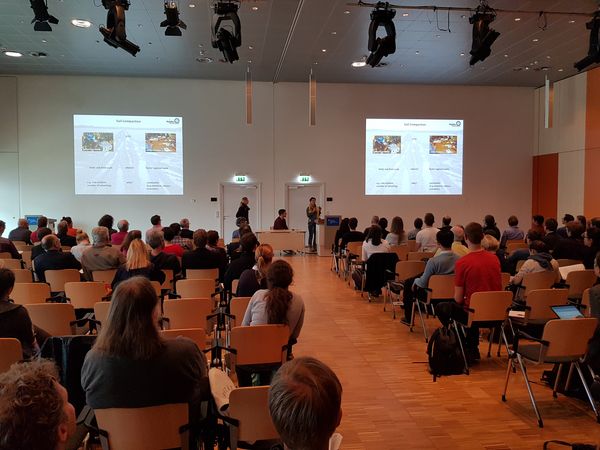
SOILAssist was represented at the BonaRes Status Seminar (02/18/2019 - 02/20/2019) with the lecture "Towards a semantically grounded on-board assistance system for ensuring soil protection during harvest" by Joachim Hertzberg (Osnabrück), two poster elevator pitches, and ten posters.
Doctorate Dr. Michael Kuhwald February 2019
Our colleague Michael Kuhwald (CAU Kiel) has successfully completed his doctorate. We congratulate him very much!
Latest publication January 2019
Augustin, K., Kuhwald, M., Brunotte, J. and Duttmann, R.
Biosystems Engineering, 180, 108-120
SOILAssist at the SSSA 2019 in San Diego
SOILAssist was represented at the Soil Science Society of America conference "Soils Across Latitudes International Soils Meeting" (01/06/2019 - 01/09/2019) in San Diego, USA.
Contribution: M. Lorenz, M. Siekmann and J. Brunotte: Liquid manure application in spring – effects of different application techniques on soil properties
